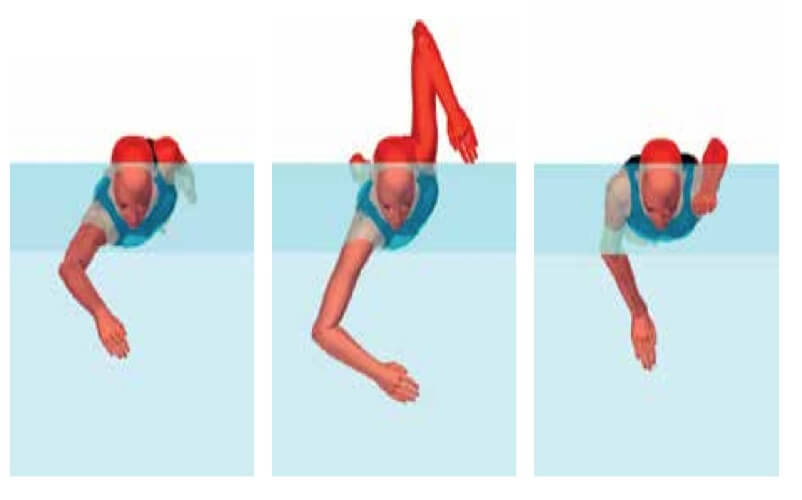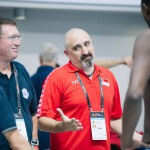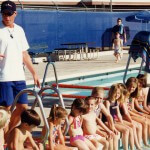Maximum Velocity

Maximum Velocity
The articles of the previous two months (July and August) addressed the technique misconceptions of hull length and hull speed. Examination of these boat-design concepts indicates that they are not applicable to human swimming. This month’s article examines the related misconception “that humans are approaching the limit to freestyle swimming performance.”
This month’s technique article from Dr. Rod Havriluk addresses two important questions regarding barriers in faster swimming: Is there a resistance barrier to faster swimming? And is there a propulsion barrier to faster swimming? Havriluk carefully examines the mechanics of freestyle in order to look closer at the propulsive phases of the arm and determine the effectiveness of the freestyle stroke.
More of this article on pages 34 and 35 of the September 2015 Issue of Swimming World Magazine. The article was written by Dr. Rod Havriluk who is a sports scientist and consultant who specializes in swimming technique instruction and analysis. His unique strategies provide rapid improvement while avoiding injury. Learn more at the STR website—swimmingtechnology.com.
Get your copy of the September 2015 Issue of Swimming World Magazine now!
Curious what else you will find in the In the September 2015 issue of Swimming World Magazine?
Check out the inside Swimming World video:
Not a subscriber? Swimming World Magazine Subscription gives you unlimited access to all online content on SwimmingWorldMagazine.com and access to all of the back issues of Swimming World Magazine dating back to 1960! Purchase your Total Access Subscription TODAY!
FEATURES

010 HAPPY (SWIMMING) NEW YEAR!
by Annie Grevers
Here are three out-of-water resolutions to make you better in the water: a champion’s warm-up, a champion’s diet and a champion’s mentality.
014 TRANSITIONING TO COLLEGE
by Michael J. Stott
Adjusting to college swimming is a challenge for any incoming freshman. With the need to balance academics, athletic obligations and a social life, time management becomes incredibly important.
016 CARMEL: GREATEST GIRLS’ HIGH SCHOOL TEAM EVER?
by Annie Grevers
For the fourth time in five years, Carmel High School reigns as Swimming World Magazine’s girls’ national high school champions. This also marks the ninth time that its girls have been dubbed public school champs since winning their first title in 1995.
020 A CHAMPIONSHIP SENDOFF
by Annie Grevers
In Sergio Lopez’s last season as head coach of the Bolles School, his boys’ team responded by winning the school’s sixth Swimming World Magazine boys’ national high school team title.
025 WHAT WE LEARNED FROM KAZAN RUSSIA 2015
by Jeff Commings
This year’s World Championships had both breakout performances as well as subpar showings, but the main lesson learned from this year’s World Championships in Kazan is that what really matters is next year’s Olympics in Rio de Janeiro.
029 LEARN HOW TO SWIM
by Jeff Commings and Annie Grevers
Drowning is the No. 1 cause of death in children under 5, which has led people worldwide to acknowledge a growing need for swim schools. Swimming World Magazine takes a look at the business side of running a swim school and explores the importance of its curriculum.
033 ASCA EDUCATES THE WORLD
by Chuck Warner
The ASCA education program reaches coaches from countries as far as China, Brazil, Kenya, India, Tunisia and South Africa to provide ASCA course work and put the content of coaching into practical context.
TRAINING
036 CROSSWIM TRAINING
by Shoshanna Rutemiller
In an effort to sidestep swimmer burnout, Jonny Tunstall—1996 200 breaststroke British national champion, Arizona State University men’s swimming alumnus and associate head coach at Sun Devil Masters in Tempe, Ariz.—created an hour-long workout that combines high-intensity interval training, swimming, running, calisthenics and other related exercises.
COACHING
008 LESSONS WITH THE LEGENDS: DERYK SNELLING
by Michael J. Stott
034 SWIMMING TECHNIQUE MISCONCEPTIONS: MAXIMUM VELOCITY
by Rod Havriluk
The articles of the previous two months (July and August) addressed the technique misconceptions of hull length and hull speed. Examination of these boat-design concepts indicates that they are not applicable to human swimming. This month’s article examines the related misconception “that humans are approaching the limit to freestyle swimming performance.”
039 Q&A WITH COACH GREG RHODENBAUGH
by Michael J. Stott
041 HOW THEY TRAIN SAM TIERNEY
by Michael J. Stott
JUNIOR SWIMMER
043 UP & COMERS
COLUMNS
006 A Voice for the Sport
038 Moms at Meets
044 Gutter Talk
046 Parting Shot










Luis Rogerio Arapiraca
Brittany Archer
Daniela Fuentes Jimena Fuentes Marisol Mendoza
Charu Hamsini Meenakshi Kuber
Lia Savannah Ahumada Perez
My shoulders hurt just looking at the middle picture. Can you say, “impingement”?
Dave,
Thanks so much for comment. You bring up a really important point and I appreciate the opportunity to respond.
I can clearly see why you think this could cause shoulder impingement. While the arm position of the middle image reduces the space between the bones in the upper arm and shoulder, the arm is out of the water so there is minimal force on the soft tissue between the bones. In addition, most swimmers (age groupers and college swimmers) have as much flexibility (a 60 degree range of motion) as the model in the images (MONA, a biomechanical model of optimal technique). It is rare (almost unheard of) to see swimmers in this position, but only because they don’t use their full range of motion, and not because they can’t or because it causes injury.
https://swimmingtechnology.com/products/mona/freestyle/
With adults that did not swim as children, there is usually less flexibility and it is necessary to adjust their arm position on an individual basis.
Yanai et al. (2000) identified three technique elements characteristic of shoulder impingement: 1) reaching (stretching) on the arm entry, 2) internal arm rotation during the pull, and failure to externally rotate the arm during the recovery. MONA has none of these risk factors.
Ted Becker (former head trainer for the USA Olympic Swim Team) and I collaborated on a study to examine shoulder stress on the freestyle arm entry of university swimmers. One of the most interesting findings was that the females had an arm entry “time of exposure” to shoulder stress that was twice as long as the males. In addition to shoulder stress, the typical female arm position slowed the stroke rate and had a negative impact on arm coordination.
https://swimmingtechnology.com/injury-prevention-rehab/freestyle-arm-entry-stress/
Rod Havriluk
Swimming Technology Research
Pauline Sullivan please show this to Andrew
Angie Zheng Emily Emory Hsieh
Juliana Penner Goes
Diyar A. Saeed
Ben Garratt
Roberto Dominguez Ortiz
Adham Hafez
Rod Havriluk is the best
Thanks, Jackie. I look forward to seeing you in the spring.
Mary Lu Thralls ??
2fast2furiosu
Jeff Krohlow
Gabby Burdess
Blair McKolskey
Omar Assir
Craig Chantler